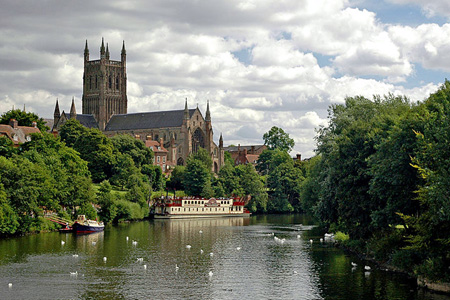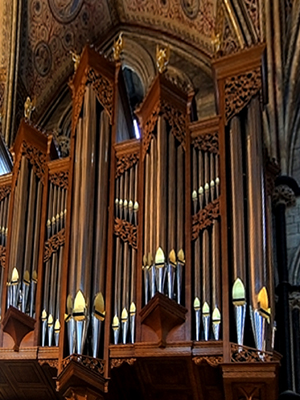| |
 |
 |
 |
| Comment on this report, or find other reports. |
 |
| Our Mystery Worshippers are volunteers who warm church pews for us around the world. If you'd like to become a Mystery Worshipper, start here. |
 |
| Find out how to reproduce this report in your church magazine or website. |
|
|
| 2770: Worcester Cathedral, England |
 |

Photo:
© Newton2 and used under license
|
 |
Mystery Worshipper: Isabella of Angouleme.
The church: Cathedral Church of Christ and Blessed Mary the Virgin, Worcester, England.
Denomination: Church of England, Diocese of Worcester.
The building: The first cathedral on the site was founded in 680 though nothing remains of it. St Oswald built its successor in 983, and established a monastery there. Following the Norman Invasion of 1066, St Wulfstan demolished Oswald’s building and began the present building, of which the crypt still survives. His successors gradually replaced everything above ground. The cathedral was badly damaged in the English Civil War in the 17th century. Restoration was carried on into the 19th century. This varied history means that all major periods of English architecture between 1066 and 1875 are represented in the cathedral today. The quire (where the service was held) is dominated by two things: the high altar at the east end, and the pipes of the quire organ, which are suspended from the north and south walls above the congregation, reaching right up to the clerestory, where they are surmounted by gilded angels carrying musical instruments.
The church: The cathedral is the mother church of the diocese of Worcester, which covers a large area of the English West Midlands. The traditions of learning and scholarship established by the monastic foundation have been maintained through the centuries, evidenced by the wealth of documents and artifacts surviving in the cathedral library, among them King John’s original will. The cathedral still has a thriving education programme, welcoming many visiting school parties for pilgrimage experiences, and offering a programme of arts events and public lectures in partnership with various organisations including the University of Worcester. The cathedral has links with the dioceses of Peru, Morogoro (in Tanzania) and Magdeburg (in Germany); more locally it strongly supports the work of the Maggs Day Centre for homeless people.
The neighbourhood: Worcester Cathedral stands in the middle of Worcester’s commercial centre, at one end of the main shopping street. It commands a magnificent view over the nearby River Severn (though one has to climb its tower to appreciate the view fully). Immediately adjacent to the cathedral on both sides are public spaces commanded by mature trees, and at the west end gardens slope down toward the river alongside monastic ruins. It is probably best seen from the far side of the river to the west, across the nearby cricket ground, above which it rises majestically on the horizon. Beyond these comparatively sylvan glades there is a busy modern city; the hum of its traffic penetrates into the building.
The cast: The Very Revd Peter Atkinson, dean of Worcester; the Revd Canon Dr Michael Brierley, canon precentor; Dr John Rowntree, director of music at Douai Abbey, who gave the address; the lay clerks and girl choristers of Worcester Cathedral choir, directed by Dr Peter Nardone, organist and director of music; Christopher Allsop, assistant director of music (playing the organ). Lessons were read by Dr Nardone and by his predecessor, Adrian Lucas.
The date & time: 4 October 2014, 4.30pm.
Comment:
We have received a comment on this report.
What was the name of the service?
Memorial Evensong for Kenneth Hugh Tickell. Kenneth Tickell, who died suddenly on 24 July 2014 of a pulmonary embolism, was one of Great Britain's premiere organ builders, whose works include the current Worcester Cathedral quire organ as well as instruments in Westminster Abbey, St Paul’s Cathedral, and the cathedrals at Canterbury, Lincoln, Bristol, Truro, St Davids and Hereford. It was appropriate that his memorial service should be held directly below the ranks of pipes he designed and built.
How full was the building?
The quire was pretty full – 180-200 people, representing not only the Tickell family and their friends but also every major organ-building firm in the UK. There were perhaps another 20 worshippers/onlookers in the cathedral nave.
Did anyone welcome you personally?
Yes. There were several individuals who smiled, handed out service booklets, and directed people to seats. Cathedral vergers in red gowns were also in evidence.
Was your pew comfortable?
My pew was comfortable, nicely padded with a cushion. Other worshippers were less fortunate – those sitting nearer to the high altar had to occupy hard chairs that did not look so comfortable.
How would you describe the pre-service
atmosphere?
Gossipy. Plenty of people greeting people they knew (but do not see often) and conveying condolences to the bereaved family. However, they quietened down when the organist started to play before the service actually started.
What were the exact opening words of the
service?
The words to Charles Viliers Stanford's setting of Psalm 119: "Beati quorum via integra est, qui ambulant in lege Domini” (Blessed are those whose way is blameless, who walk in the law of the Lord), sung by the choir. These were followed by spoken words of welcome from the dean.
What books did the congregation use during the
service?
A service booklet prepared specially for this service, including hymn words and tunes.
What musical instruments were played?
The Tickell & Co quire organ. It was built in 2007-2008, replacing an older instrument described by one critic as "a most unsuitable hotch-potch of inferior quality, housed in ugly Victorian cases."
Did anything distract you?
Someone’s mobile phone beeped just as the choir conductor stepped onto his rostrum to direct the Nunc Dimittis. It was a whoopee cushion moment.
Was the worship stiff-upper-lip, happy clappy, or
what?
Reverent: typical cathedral-style Anglican, but not uncomfortably stiff. It was a hugely moving tribute to Kenneth Tickell.
Exactly how long was the sermon?
9 minutes.
On a scale of 1-10, how good was the preacher?
9 – Deeply sincere. The address was a eulogy, wonderfully personalised because the speaker had known Kenneth Tickell for a very long time.
In a nutshell, what was the sermon
about?
Having learned his craft working for other organ builders, Kenneth Tickell set up his own company in 1986. Between then and his death, his company built 82 organs. It is a quirk of the trade to assign each organ an opus number, in the same way that composers do. Opus 1 was a tiny organ with a single manual (keyboard) and three stops, built for a little country church; subsequent instruments grew in size and complexity and have been installed not only in the UK but in countries across the world, including Australia and Japan. The congregation were invited to appreciate the vision, skill, dedication and enthusiasm of the man whose life work this was, and to be grateful that we are still able to enjoy its fruits whenever the instruments are played.
Which part of the service was like being in
heaven?
The address was uplifting, and the choir’s rendering of the second anthem, John Ireland’s Greater Love, was magnificent and moving. It was also rather wonderful that at the end members of the congregation, with only a couple of exceptions, remained in their seats and in silence to listen to the organ voluntary, applauding warmly at the end. There was one more heavenly moment, which I will come to later.
And which part was like being in... er... the other place?
The distant sound of a fire engine (or it might have been an ambulance) was mildly intrusive during one of the quieter moments.
What happened when you hung around after the service looking lost?
There was no opportunity to linger. After the organ voluntary, everyone started moving relentlessly down the central aisle and along the cloisters to the chapter house, where refreshments were waiting. After refreshments, most of those who had attended the service moved back into the quire for an organ recital given by Olivier Latry, organiste titulaire of Notre Dame in Paris. Further folk trooped in from outside, so the quire was populated by well over 200 people by the time the recital started. Monsieur Latry performed from memory a programme encompassing music by Dupre, Franck, Vierne, Liszt and Widor, and received a standing ovation. At this point he announced that for an encore he wished to improvise on the last hymn from the service earlier in the evening. This was the Herbert Howells setting of “All my hope on God is founded.” He invited us to sing it again at the end of his improvisation. The harmonies of the accompaniment also became progressively more adventurous for each verse as choral confidence increased. A further standing ovation followed. It was a very memorable way to end both the recital and the whole occasion, and the last heavenly moment of the day. Many people were still standing in the quire talking it all over as I left the building.

Photo:
© TheElfFromAbove and used under license
How would you describe the after-service
coffee?
Hot and flavoursome. There was also tea, and lavish platters of cake, generously chunked.
How would you feel about making this church your regular (where 10 = ecstatic, 0 = terminal)?
10 – The service was prepared meticulously by all involved and ran smoothly, with superb music. The congregational singing was enthusiastic.
Did the service make you feel glad to be a
Christian?
Yes.
What one thing will you remember about all this in seven days' time?
The Latry improvisation with full congregational participation. |
|
|
 |
 |
 |
| We rely on voluntary donations to stay online. If you're a regular visitor to Ship of Fools, please consider supporting us. |
 |
 |
 |
| The Mystery Pilgrim |
 |
| One of our most seasoned reporters makes the Camino pilgrimage to Santiago de Compostela in Spain. Read here. |
 |
 |
 |
| London churches |
 |
| Read reports from 70 London churches, visited by a small army of Mystery Worshippers on one single Sunday. Read here. |
| |
|
|
|
|


